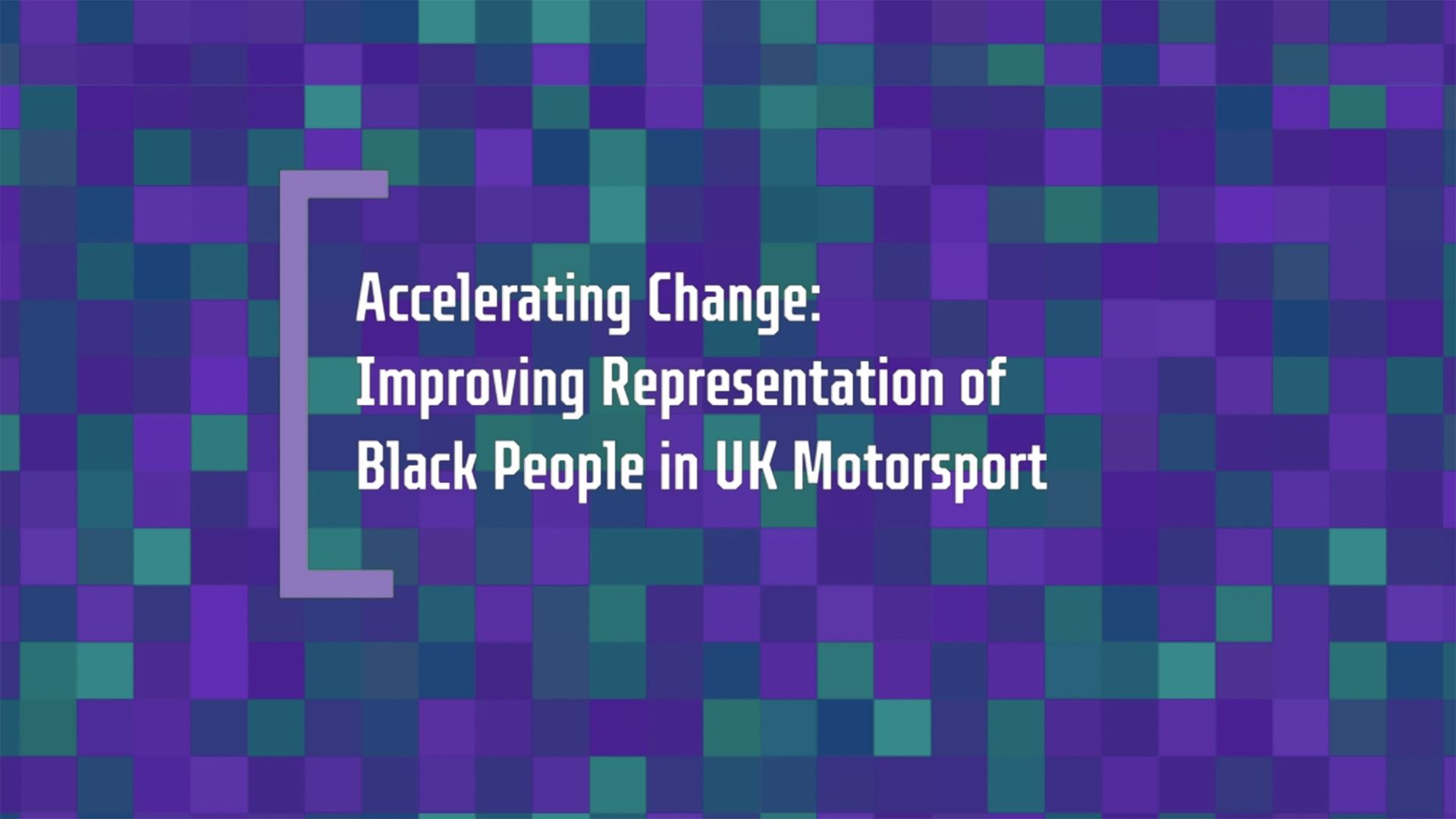

Black people are hugely underrepresented in UK motorsport - something Lewis Hamilton has witnessed first hand throughout his career.
The reasons for this are complex and often interlinked, but include motorsport industry practices, university admissions, classroom culture and more.
Lewis launched The Hamilton Commission, alongside the Royal Academy of Engineering (RAE), to understand why this underrepresentation persists, and look for ways to change the industry for the better. To do so, meant considering a broad set of underlying causes, many of which are systemic in nature.
This research-led report explores the barriers and challenges facing Black people on their journey through education - focussing specifically on STEM subjects and engineering - and ultimately into UK motorsport.
The Commission set out to develop a set of practical, actionable recommendations that would improve the representation of Black people in UK motorsport.
The report provides ten recommendations, which are practical and actionable, because the time for change is now.
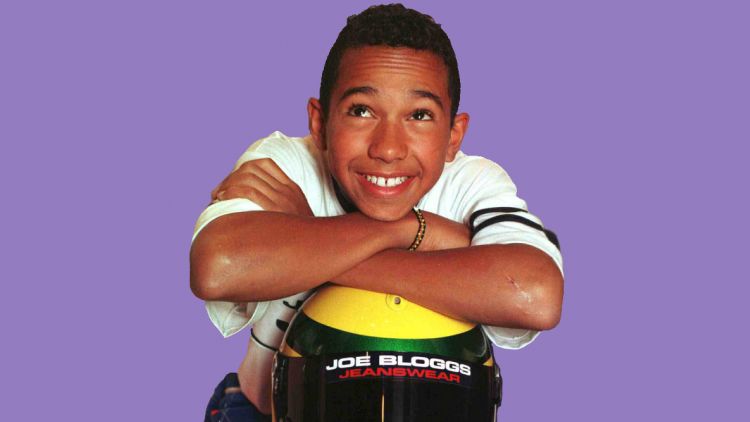
I was five years old when my dad bought me my first radio-controlled car. I spent every Saturday and Sunday racing and was obsessed with how much I could improve.
Six years later I started secondary school. No matter how hard I worked I was told I wasn’t smart enough, that I had no potential. No future.
Today, I’m a Seven-Time World Champion, holding the highest number of wins, poles, and podium finishes in the world of Formula One.
I am the same boy who got told he’d never achieve anything. The one thing that connects that boy with me today, is opportunity.

Dr Hayaatun Sillem CBE, the first woman and the first person of colour to be CEO of the Royal Academy of Engineering.
“Engineers shape our world. They design and create products and services that power and define our lives. But our community is not representative of the society we serve.
Motorsport inspires and influences hundreds of millions of people around the globe. Formula 1 exemplifies the spirit of creativity, innovation and excellence that drives so many engineers, wherever they work.
With the support of our expert Commissioners and the personal leadership of Lewis Hamilton, we have worked to understand how to accelerate the pace of change on racial diversity in motorsport.
My hope is that this report will serve as a catalyst for action and stimulate the creation of cultures which will attract, retain and inspire many more talented Black engineering and STEM professionals across the full spectrum of UK motorsport roles."

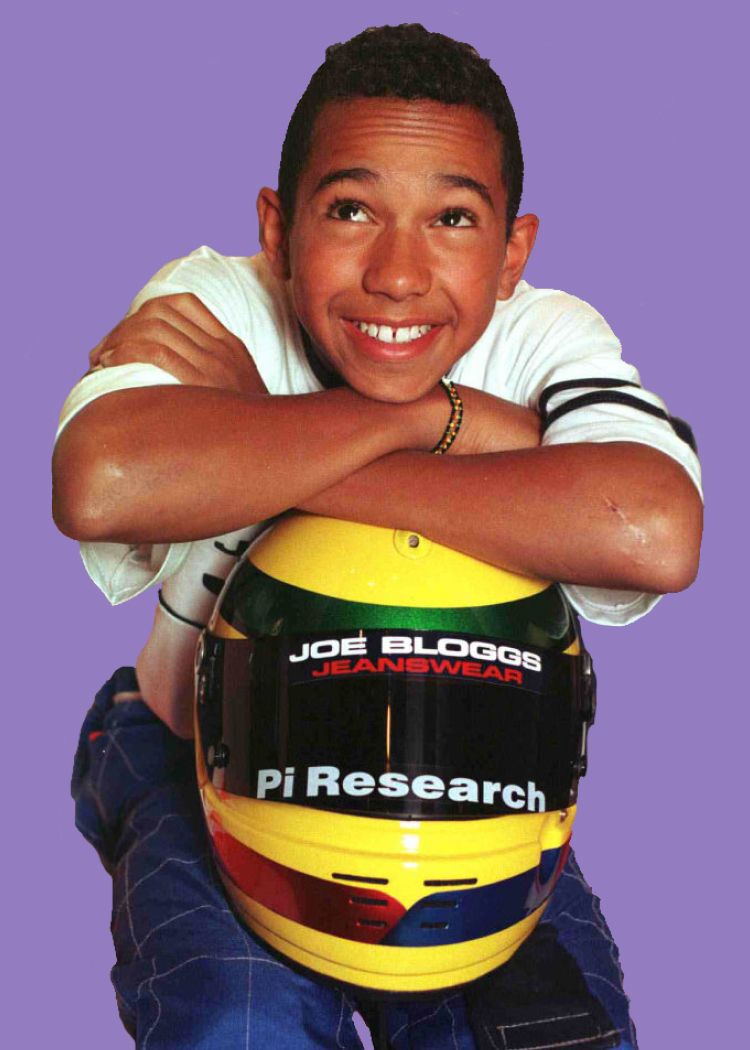
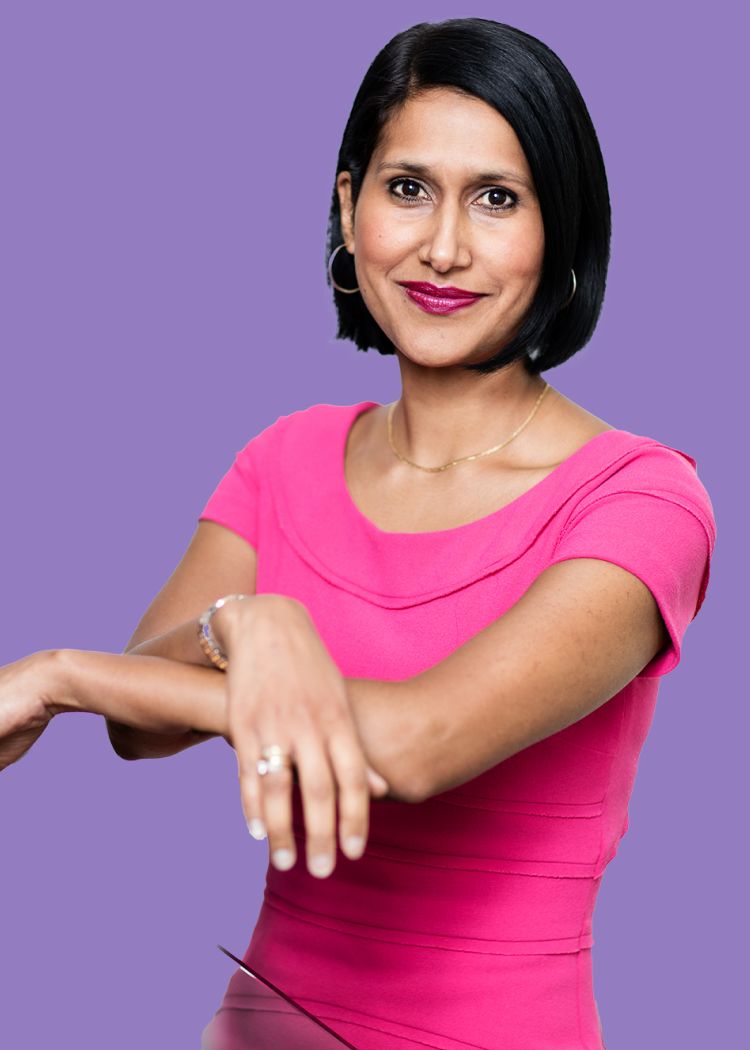
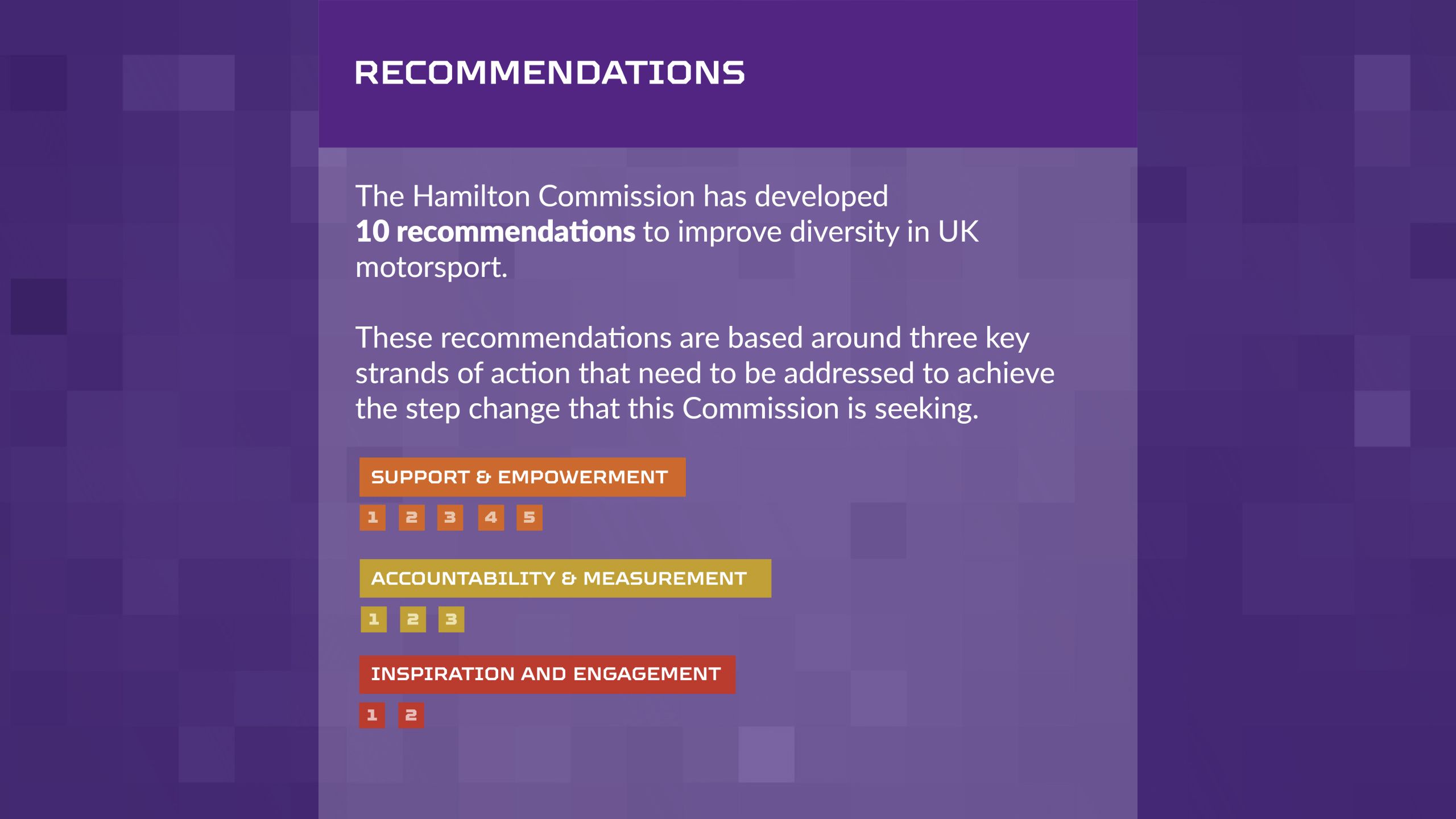
F1 & UK
MOTORSPORT

MOTORSPORT IS TRULY A GLOBAL SPORT
The Federation Internationale De’ l’Automobile (FIA) oversees 245 motoring and motorsport club members across 146 countries, which represent 80 million individual members.
Disciplines in motorsport range from Formula 1 - the pinnacle of the sport - to circuit or track-based competitions such as Formula 2 and 3, Endurance, Touring Car, Formula E, and others such as Cross-Country, Offroad and Rally.
Motorsport Valley
Most of these companies are small or medium businesses, employing typically around 30 to 50 people and largely based in Motorsport Valley - a 200 square mile stretch of England between Northamptonshire and Oxfordshire.
These companies support a range of competitive racing disciplines as well as the engineering supply chain providing design, development and manufacturing of high-performance components, engines, control systems and cars.
Engineering is at the heart of many careers in motorsport, being key to the design, manufacture and maintenance of the cars.
The research team focused on identifying the barriers that may be standing in the way of success in these subjects and progression to engineering careers.

DIVERSITY IN
UK MOTORSPORT

It's easy to make a case for more diversity in the workplace
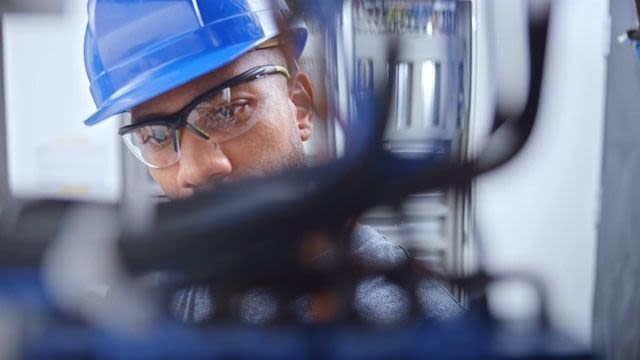
Not only is it the right thing to do, but evidence shows that businesses that have diverse teams are more competitive, profitable and innovative.
The most ethnically diverse companies are 30% more likely to have financial returns above the national average.
In research conducted by the RAE, 83% of engineering organisations said that “enhancing capacity for innovation and creativity” was what was driving their efforts to increase diversity and inclusion.
The FIA, Motorsport UK and some Formula 1 teams have established programmes to address diversity challenges although, until 2020, the focus was on improving the number of women in the sport.
Discrimination in sport
Discrimination and underrepresentation in sport are not new challenges.
In 2020, research found that 83% of people from Black, Asian and minority ethnic groups had experienced racism within sport.
Campaigns such as Kick it Out and Show Racism the Red Card in football, and This Girl Can have sought to promote respect and increase participation of underrepresented groups in sport.
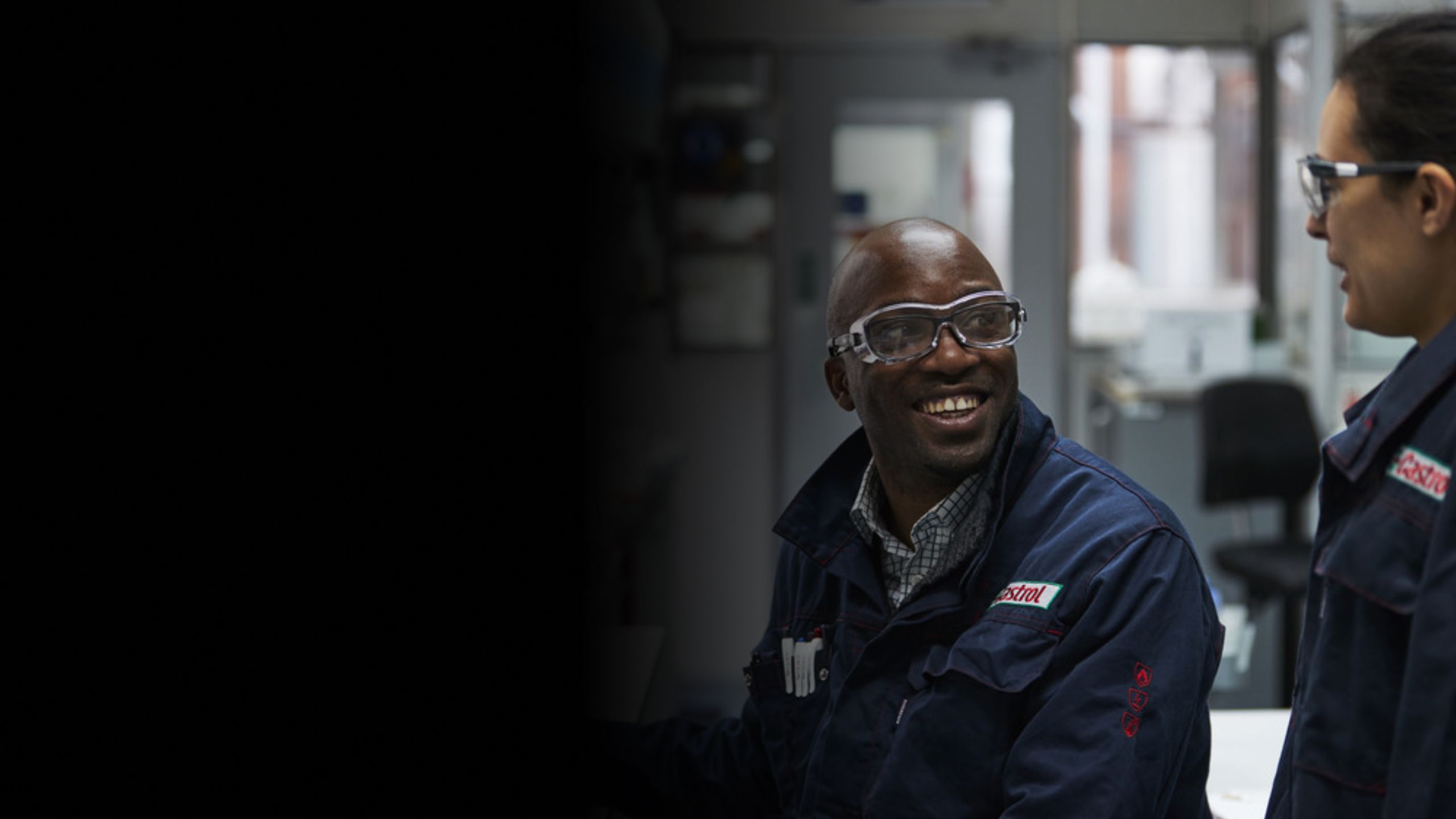


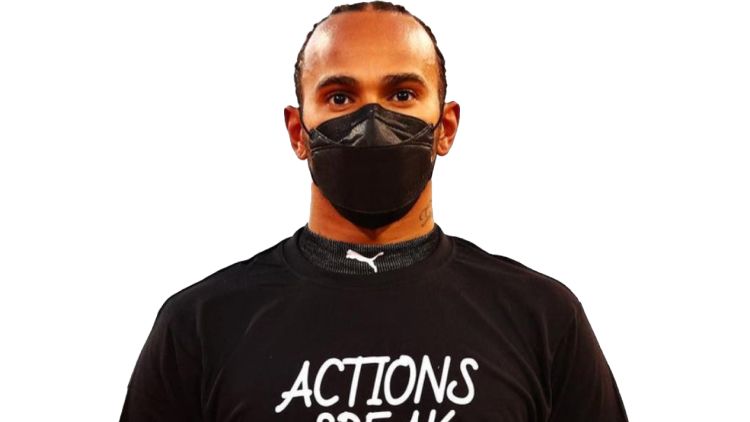
The Lewis Hamilton effect
Formula 1, FIA and motorsport organisations have been working for a number of years on improving gender equality, however, the same focus has not been given to diversity. Lewis Hamilton has always been a vocal supporter of racial equality and the need to tackle the lack of ethnic diversity in motorsport. Following the death of George Floyd in 2020 and the resulting Black Lives Matter movement, Lewis’s voice became louder and he utilised his platform to call for the urgent need for change. The industry responded with public and financial commitments to tackle racism, inequality and other challenges facing the sport.
Despite this, many challenges persist.
“I have been in the paddock for the best part of a decade, and we have never had an opportunity to talk about these issues. No one has ever asked us, so you have to admire Lewis for the stance he has taken and opening this conversation up.”
- Black male engineer, working in motorsport

Formula 1 and wider motorsport teams rely heavily on data to improve racing performance, but the Commission found little data available on the number of minority ethnic people in the workforce.
From interviews with senior HR managers, we estimate that less than 1% of the workforce in Formula 1 comes from Black or other minority ethnic backgrounds.
Immediate opportunity
A simple way to start the process of working towards more diversity and inclusivity would be for motorsport organisations to start collecting detailed, granular data on the diversity of the workplace, and making it available.
From this, a baseline measure can be created and organisations can start to put in place targets and interventions for improvement.
Leadership from the governing bodies, the FIA and Motorsport UK, the Formula 1 organisation, and from the owners, chief executives and team principals in Formula 1 teams is key to making this happen.

The culture in motorsport
We can’t improve diversity if we don’t also create more inclusive cultures in the workplace.
The research team found that people from Black and other minority ethnic backgrounds and women in motorsportoften had to endure banter that crossed the line and which they found offensive. Some felt they had to put up with it or ‘laugh it off’, but continual microagressions can leave people feeling as if they are ‘lesser’ members of the team and make them unhappy at work.
If motorsport organisations are to accelerate increases in diversity, senior leaders will have to look inwards at their workplace cultures, practices and behaviours to ensure that they are inclusive for all people.

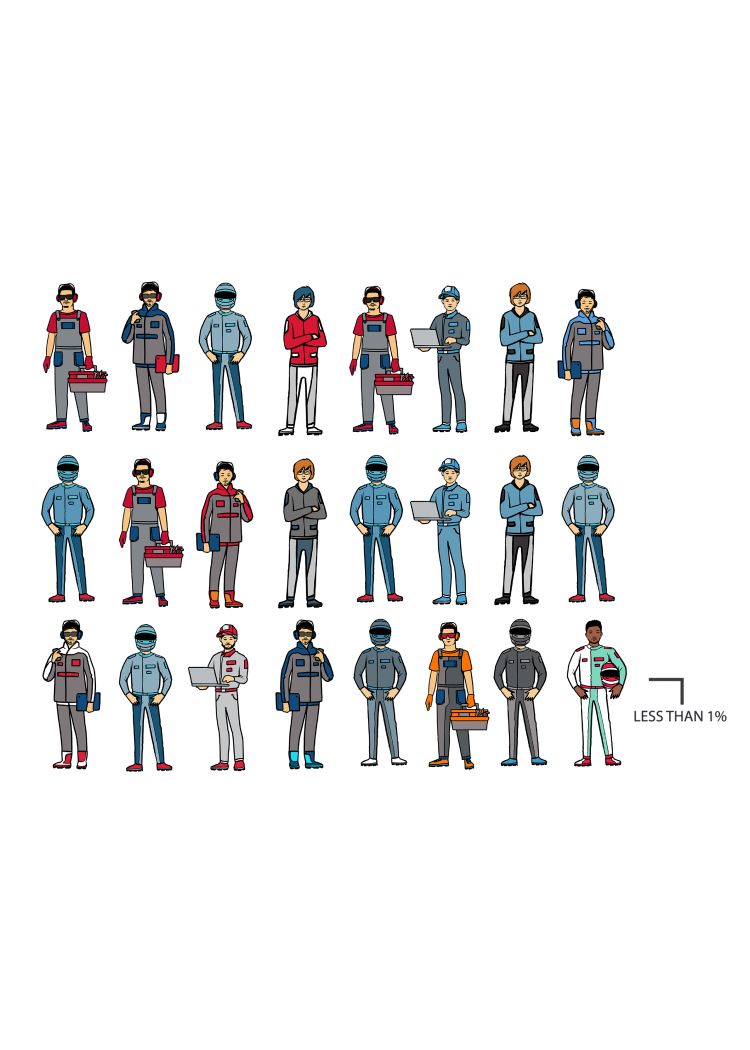

“The culture of Formula 1 can be quite off putting. Since Lewis and Black Lives Matter, I know a lot of teams now have targets to get X amount of minority ethnic engineers, but nothing’s being done about culture”.
"You can guarantee that if your senior leaders are not visibly committed to diversity and inclusion and hold people to account, their managers and teams will not either. This creates a culture where diversity and inclusion is seen as an add-on, done for show rather than because it matters to the business."
Experiences

Many of the Black people that the research team interviewed expressed their frustration at what they saw as a lack of progression for Black engineers and the lack of Black and minority ethnic people in leadership roles in the sector.
Many were sceptical about the pace of change within the industry and questioned whether senior leaders across the sport were committed to creating inclusive cultures.
Interviews with people working in HR, and responsible for recruitment into the sector, revealed a prevailing view that diversity (of any kind), although important, was secondary to identifying the best candidate to achieve the goal of improving car performance - and that was often narrowly defined by having a good degree from a top university.

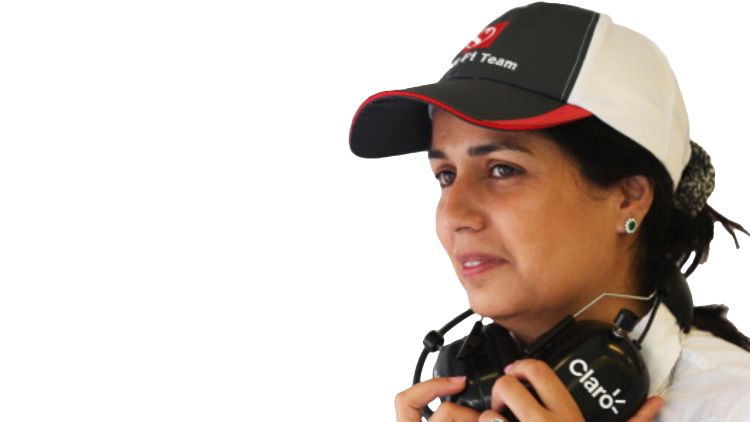
Sometimes organisations have an unhelpful and erroneous view that diversity can be addressed without necessarily changing the underlying structure of the institution and its day-to-day operations.
This can mean that leaders assert their own “colour and gender blindness”, put the emphasis on tradition and “the way things are done” and insist that the organisation is meritocratic.
What this does is externalise the issue, rather than looking inwards at how their own culture and practices may impact diversity.
A number of the Formula 1 teams interviewed for the Commission displayed some of these characteristics.
"We do not care about ethnicity – if the guy is a genius and he can make the car go faster, we will hire him."
There have only been two female and no Black Team Principals in all of Formula 1's history.
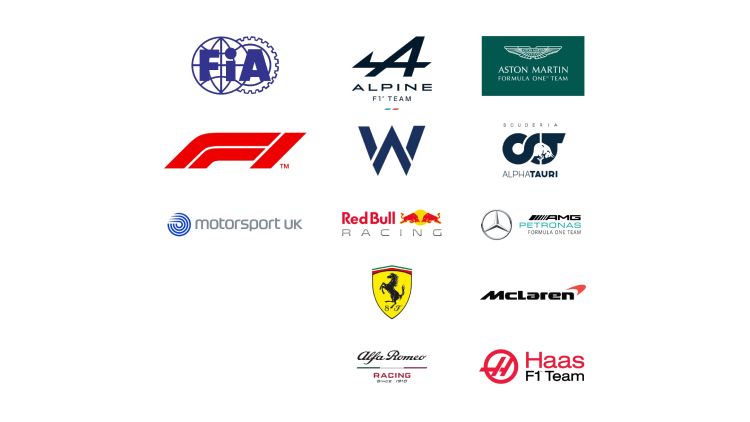
The role of leadership
One of the most critical priorities for diversity and inclusion is ensuring that leaders are committed and accept personal and corporate accountability on behalf of their organisations. Inclusive leaders set the tone for the organisation. This is even more important in SMEs, where leaders’ actions are often directly visible to all.
For motorsport, this means the Team Principals and Chief Executives of Formula 1 Teams, but also the leadership who run the governing bodies including Formula 1 and the FIA.
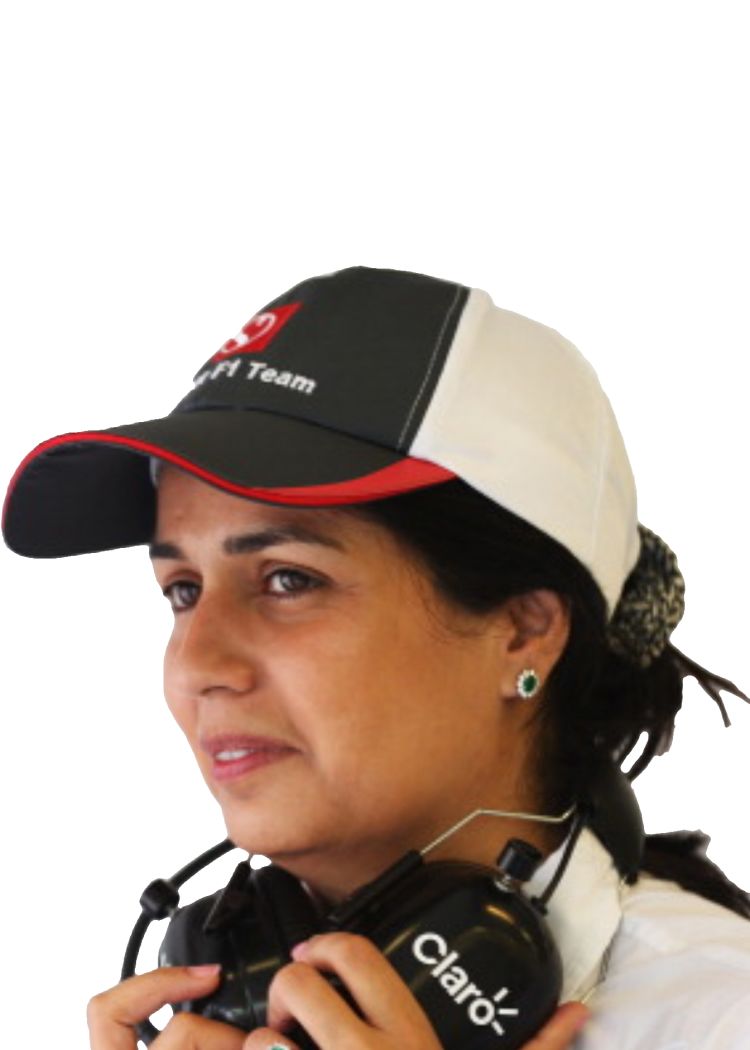
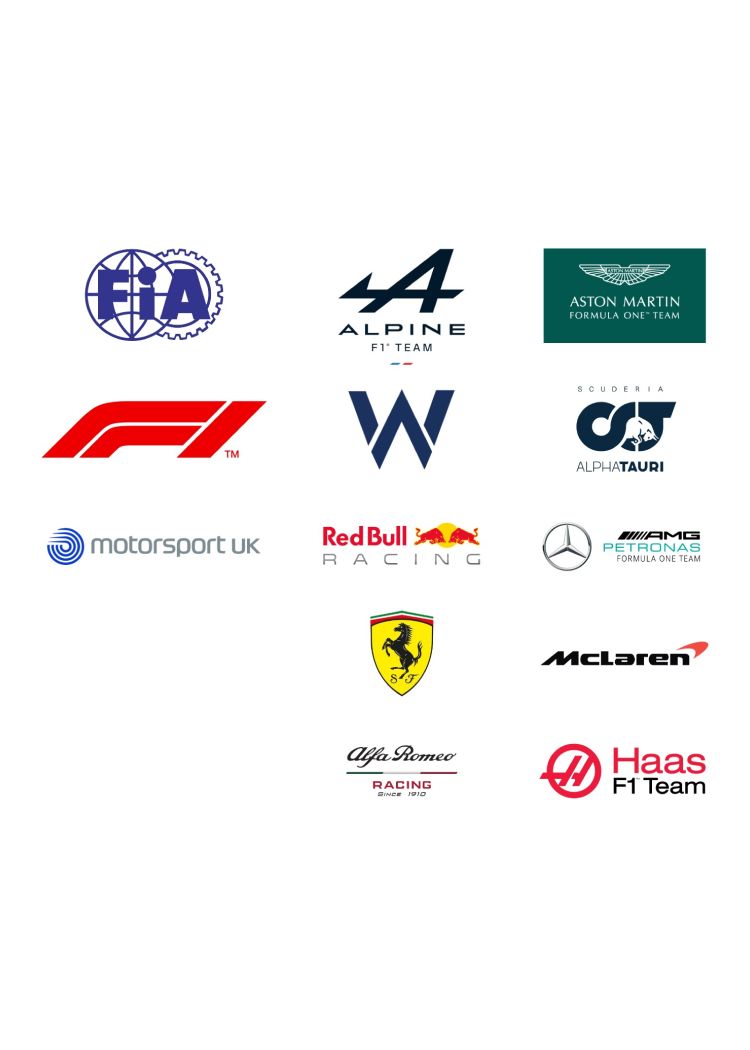
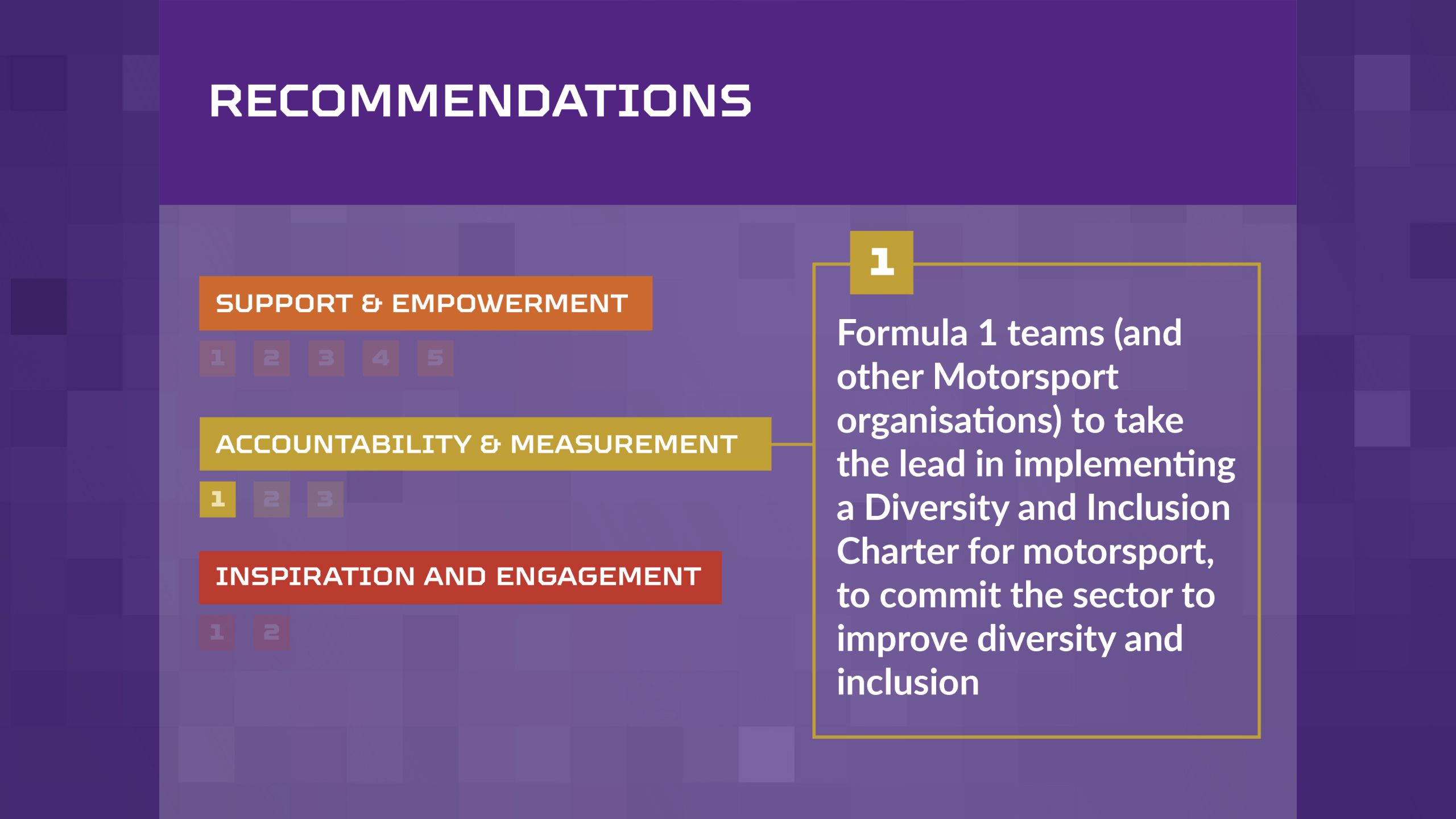
INTEREST IN
MOTORSPORT

One of the barriers to a career in motorsport for young Black people is a lack of engagement with the sport, partly because it can be seen as elitist and costly.
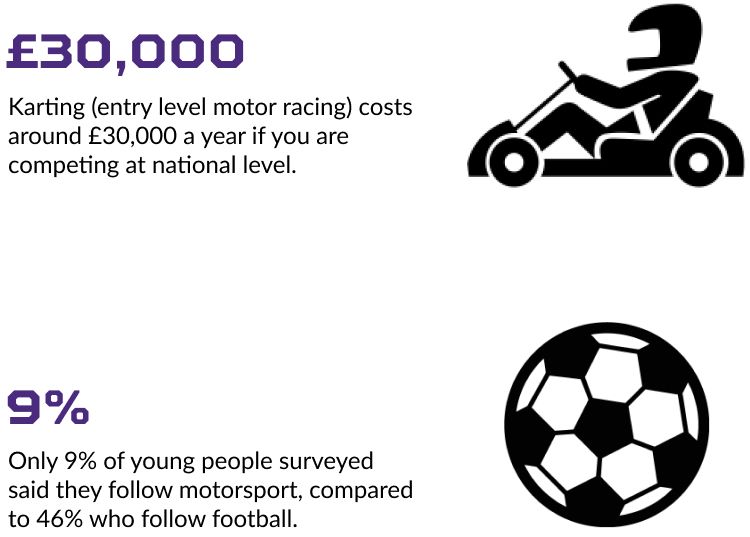
The survey and interviews with young people, commissioned for this study, showed that although many look up to Lewis Hamilton as a role model, very few follow motorsport.
Young Black people also said that they felt a career in motorsport was not for them and they wouldn’t fit in. Older Black students, especially boys, felt that it was harder for them and other diverse minority groups to get into engineering more generally. This is is partly because of a lack of visible Black and ethnic minority role models.

"We’re from Camberwell. Motorsport isn’t for us. We’re from the inner city, not the suburbs."
- Black Caribbean, Male

The research showed that another key barrier to a career in engineering or motorsport is a widespread lack of knowledge and understanding of engineering careers amongst young people of all ethnic groups.
Young people thought that engineering was:
“Too hard”. “Too technical”. “Too narrow”. “Not creative enough”.
There was confusion about who engineering is for, falling into two categories:
- Engineering is manual and hands-on, for low-skilled people.
- Engineering is more suited to students with higher academic abilities because you need mathematics and physics.
Boys, regardless of ethnic background, are more likely to consider engineering as a career than girls of the same age. However, as they get older, boys from Black ethnic groups become less likely to consider engineering, whereas there is no change among boys from White backgrounds.
Young people also said their parents and teachers were often more likely to recommend careers in law, medicine, and accountancy than in engineering.
Careers education and STEM activities
This lack of knowledge about engineering careers is despite decades of collective effort from major corporate businesses, engineering professional bodies, charitable trusts and many other organisations to promote engineering careers in schools.
However, there is a lack of evaluation being carried out by STEM activity providers to understand what works well in terms of engaging with young people and addressing their careers information needs.
Provision of STEM enrichment activity to schools is not uniformly distributed across the country and many schools have little opportunity to bring in external support for STEM engagement.

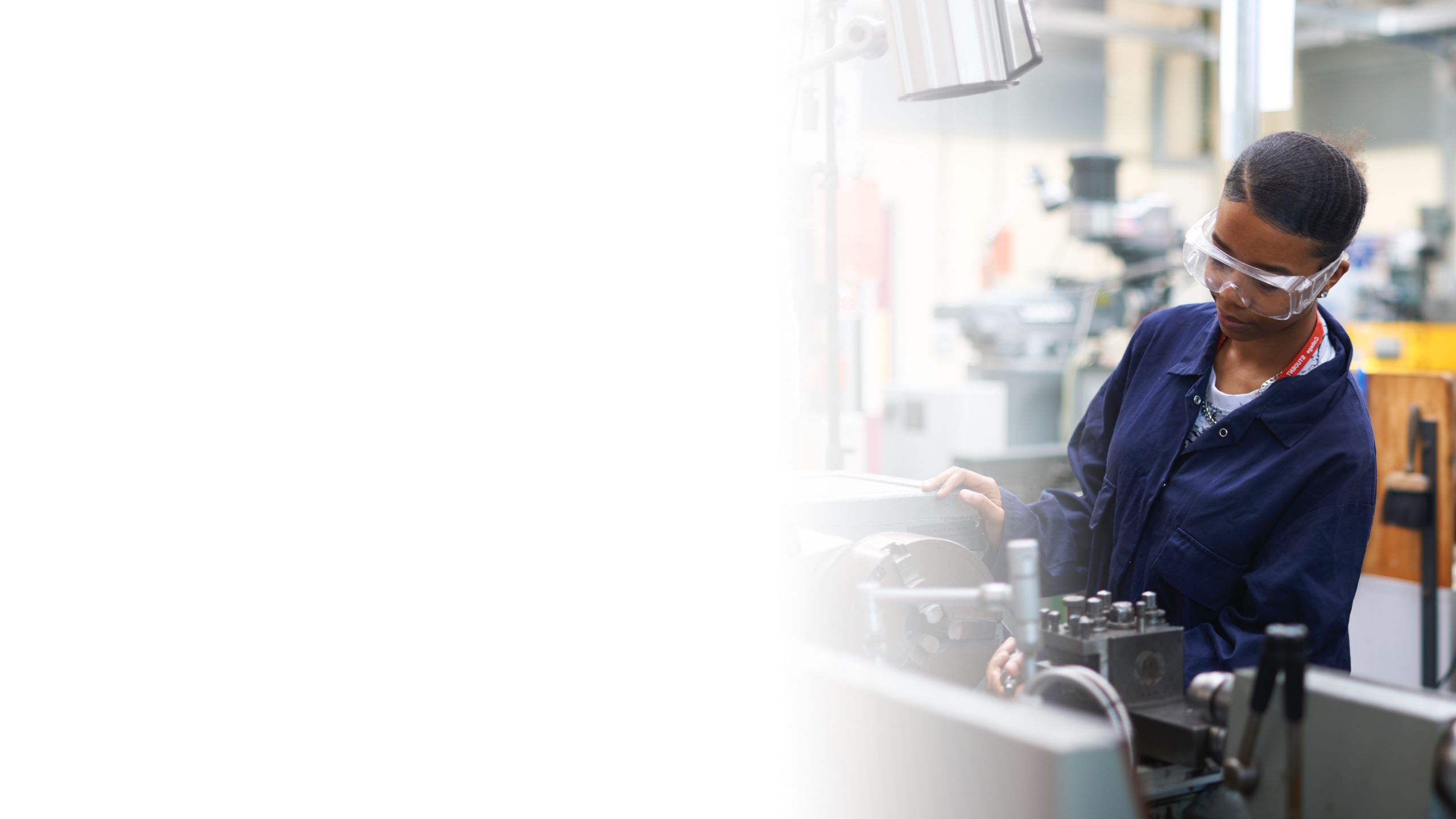
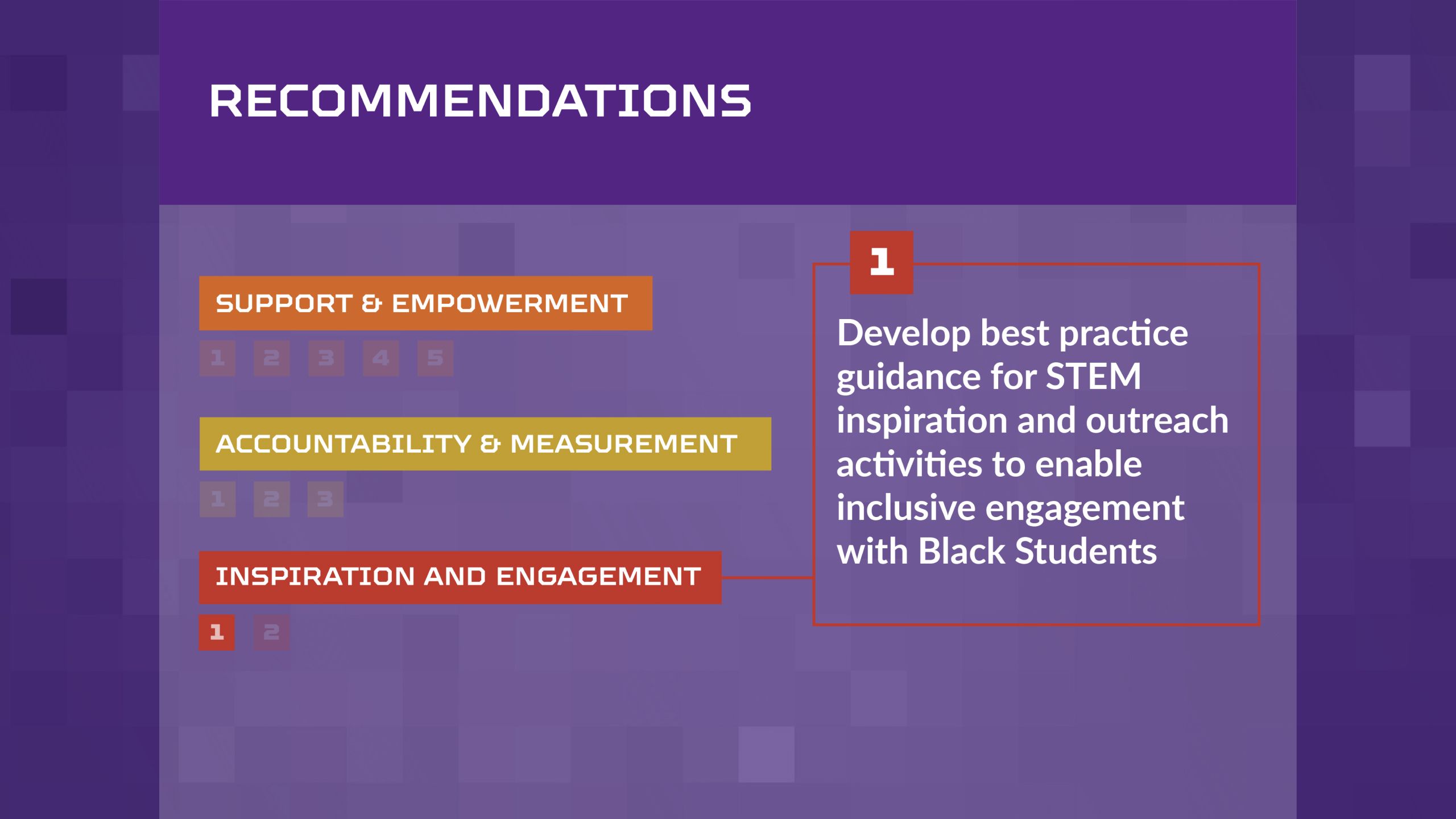
CAREER
PATHWAYS

Recruitment into the motorsport sector is competitive.
The excitement of working with some of the most challenging, high-performance engineering in existence is attractive to many engineers and technicians, so interest in jobs is high.
But the sector is small, employing only around 40,000 people, so opportunities for entry are relatively few.
Immediate opportunity
There are a number of things that companies can do quickly and easily to start being more inclusive in recruitment practices, such as checking careers marketing materials to ensure that they feature diverse images of candidates, using diverse interviewers and providing unconscious bias training to those involved in the recruitment process.
There are two main pathways into motorsport: the graduate route resulting in a professional engineering role, or the technician or mechanic route, usually via an apprenticeship or general recruitment.
The professional engineering pathway
The competitive nature of recruitment into motorsport means Formula 1 teams will often look to recruit graduates with first class honours degrees from Russell Group universities - a select group of the UK’s highest-ranked research-intensive universities.
Many existing engineers and recruiting managers also attended universities in this group.
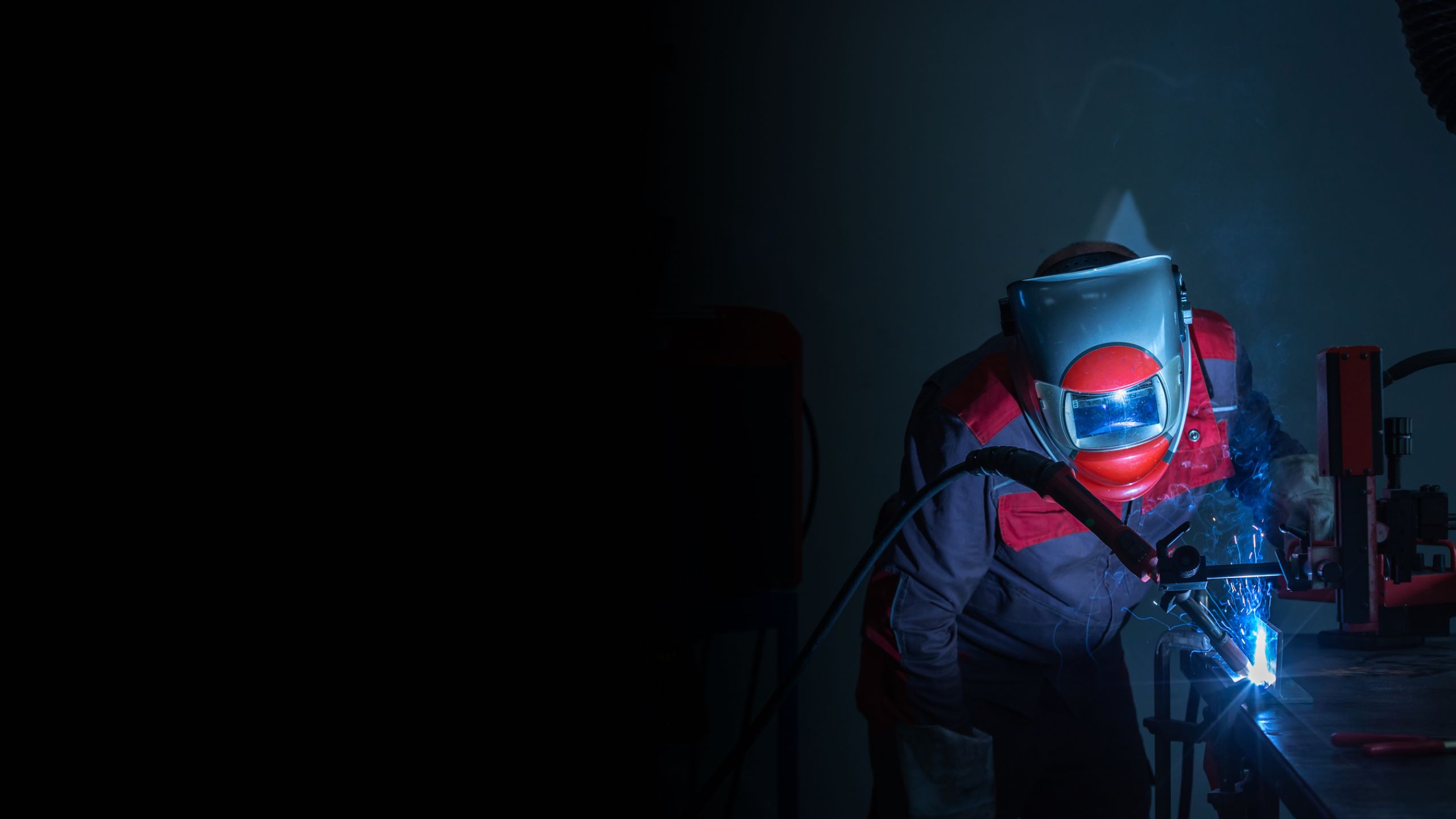
We all fish in a pond that is very small so there is less chance to find diverse people
Experiences

The research showed that in some cases the elite image of Formula 1 can even act as a deterrent to candidates from non-Russell Group universities; students consider it a waste of time to apply for roles as they don’t expect to be selected.
The high media profile of Formula 1 masks the fact that most teams are relatively small organisations with limited HR capabilities. Recruitment to five or ten graduate positions may result in over a thousand applications. As a shortcut, some teams filter to candidates with 1st class honours degrees only. Most teams recognised filtering by particular university groups resulted in less diversity; this is discouraged but many recruiting managers acknowledged that they sought out applications from universities - typically Russell Group - with which they had strong relationships.
Immediate Opportunity
If all Formula 1 teams were to target students across a wider range of universities in their recruitment process, this would help to attract and recruit more diverse talent. We strongly encourage all Formula 1 teams to take this approach.
The technician pathway
Another key entry mechanism into the sector is through apprenticeships and technician pathways. Technicians and mechanics are critical to Formula 1 and the wider sector, as they are highly skilled and have intimate knowledge of the cars, their components and systems, whether in high-precision manufacturing, fabrication and construction, or in the race teams and pit crews.
Recruitment into these specialist technical roles is often based on experience. Early career routes for young people are through apprenticeships or entry technician roles. A key challenge here, for many young people interested in joining the sector, is the geographical location of these businesses within Motorsport Valley.
With no major cities and limited public transport infrastructure in the area, opportunities are restricted to local young people or those who can afford, or are able to relocate or undertake long commutes.
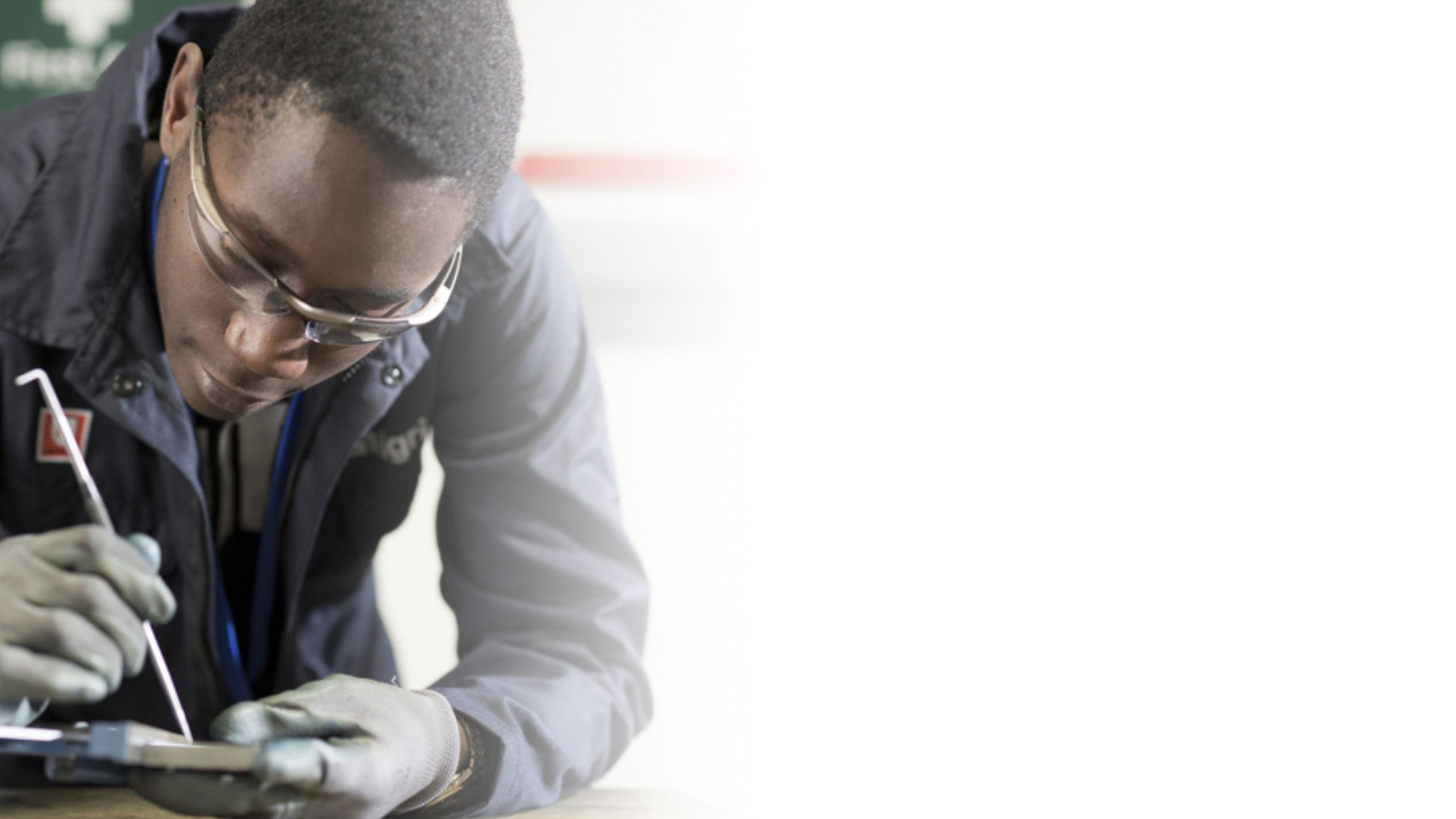
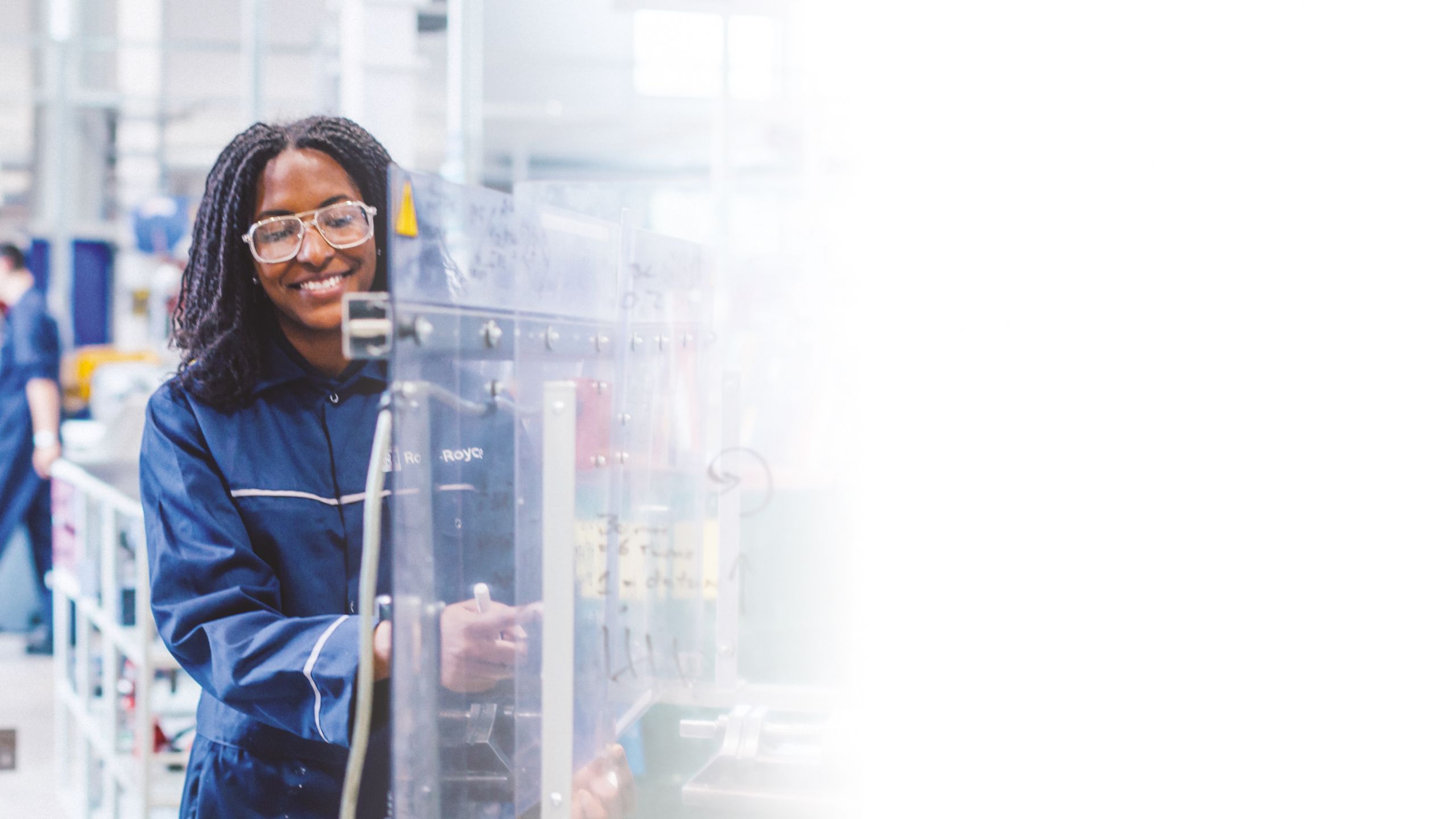
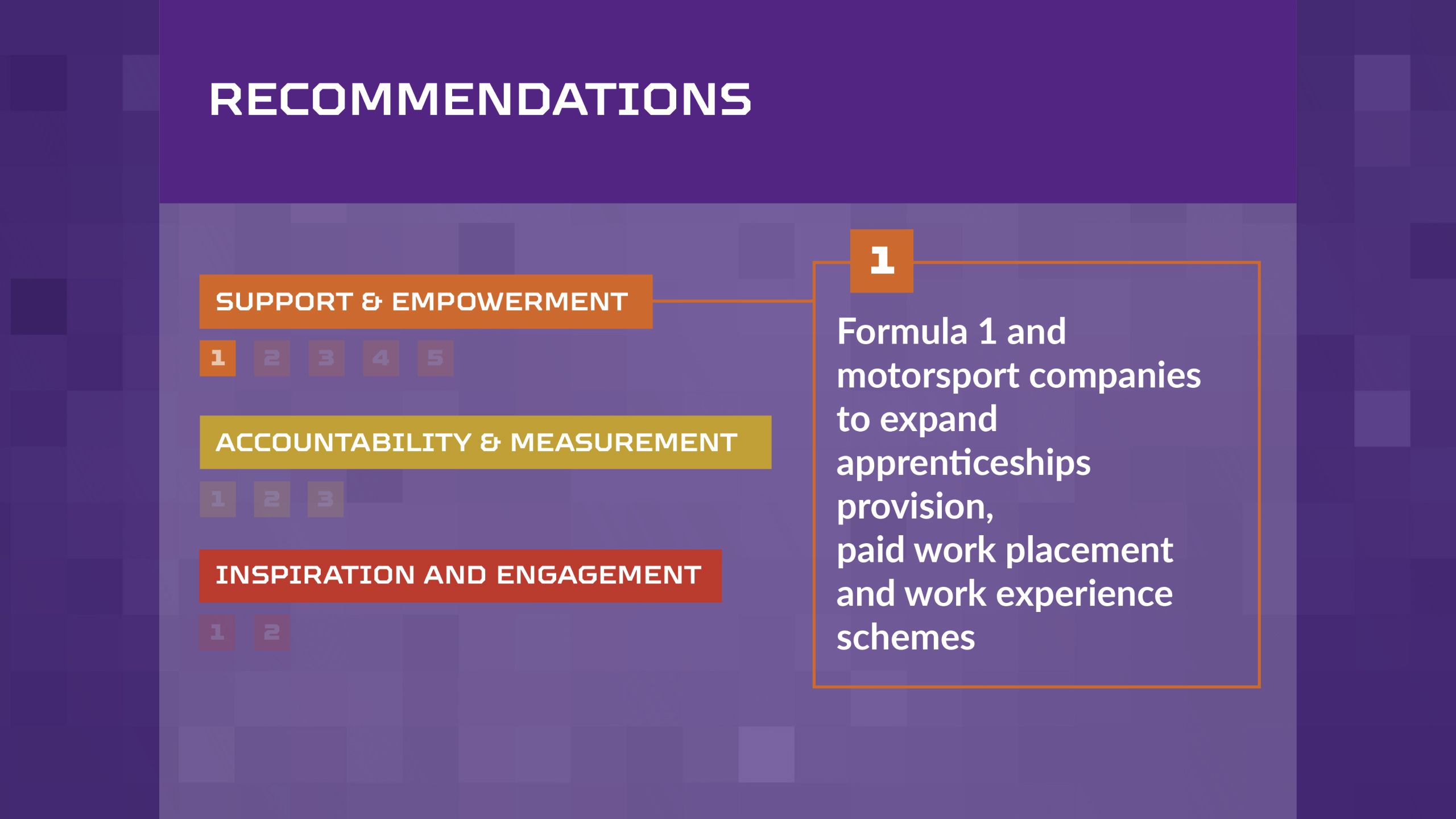
SCHOOLS
& GCSEs

In order to understand why so few Black people are in these roles across motorsport, the Commission examined the talent pipeline through the education system in England to look at the attainment and progression of young Black people into engineering and explore the barriers that may be hampering their progress.
There are just under nine million young people studying in schools in England. Over a third of these students are from Black, Asian or minority ethnic backgrounds. 5.7% of the cohort are Black and an additional 2.3% are from Mixed White and Black ethnic groups.
To pursue a career in engineering, students need to take a select group of STEM subjects (Science, Technology, Engineering and Mathematics) that support their learning and progression.
The research team found that Black African students are performing as well as, or better than, the average among all ethnic groups in science and mathematics GCSEs. However, Black Caribbean students are already well behind at this critical first formal stage of assessment.
Additionally, fewer Black Caribbean students are studying the Triple Science route - sometimes because they aren’t given the opportunity. Top set students are more likely to be offered triple science pathways but evidence shows that Black students are less likely to be placed in these top sets in schools.
This follows a more general trend of low teacher expectations towards students from Black Caribbean backgrounds in particular. The issue of entry to triple science matters because triple science is often required by schools and colleges for progression to A levels in the sciences.
Students who are eligible for free school meals do worse, in general, regardless of ethnicity, in all subjects - the dominant factor here is poverty.


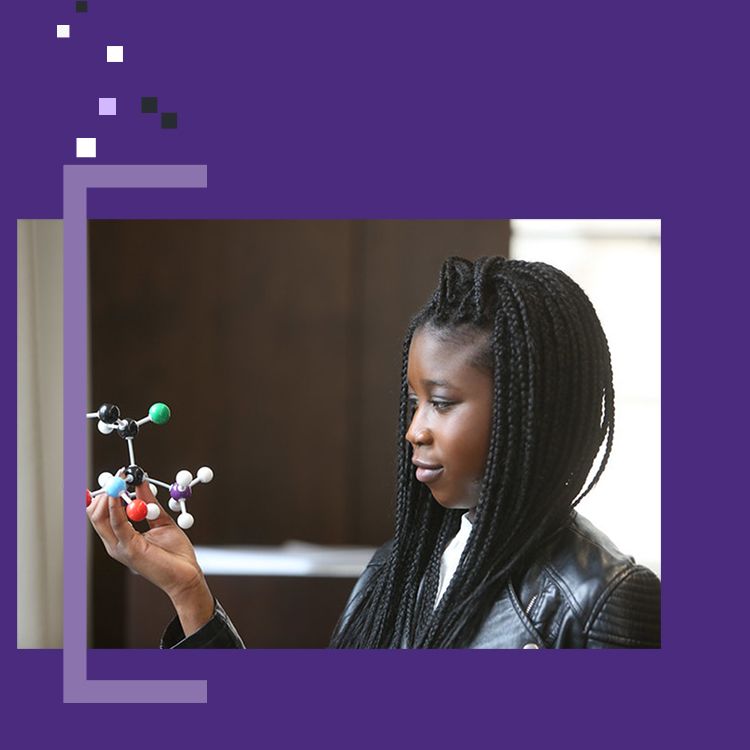
If we want to see more young Black people in engineering and motorsport, it’s critical that they participate in STEM subjects and achieve good grades.
The Commission found a wide variety of published research that gave insights into the barriers that affect this progression. These barriers include the following:
Barrier 1: Limited activity in schools to address issues
The Commission found evidence accumulated over many years which highlights inequalities experienced by young Black people in school, particularly with respect to Black Caribbean students, such as high levels of exclusions and low expectations of teachers leading to streaming of young Black students into lower ability groups for mathematics and sciences.
Barrier 2: Role models
A lack of Black teaching role models in schools and a lack of Black and minority ethnic leaders in schools. Research shows that 86% of teachers are White British while only 65% of students are from a White British background.
Barrier 3. Behaviour management
There is concern within the Commission that the current trend in behaviour management in schools towards stricter policies and escalating sanctions is disproportionately affecting Black students.
The research shows that Black Caribbean students were around 1.7 times more likely to be permanently excluded compared with White British students.

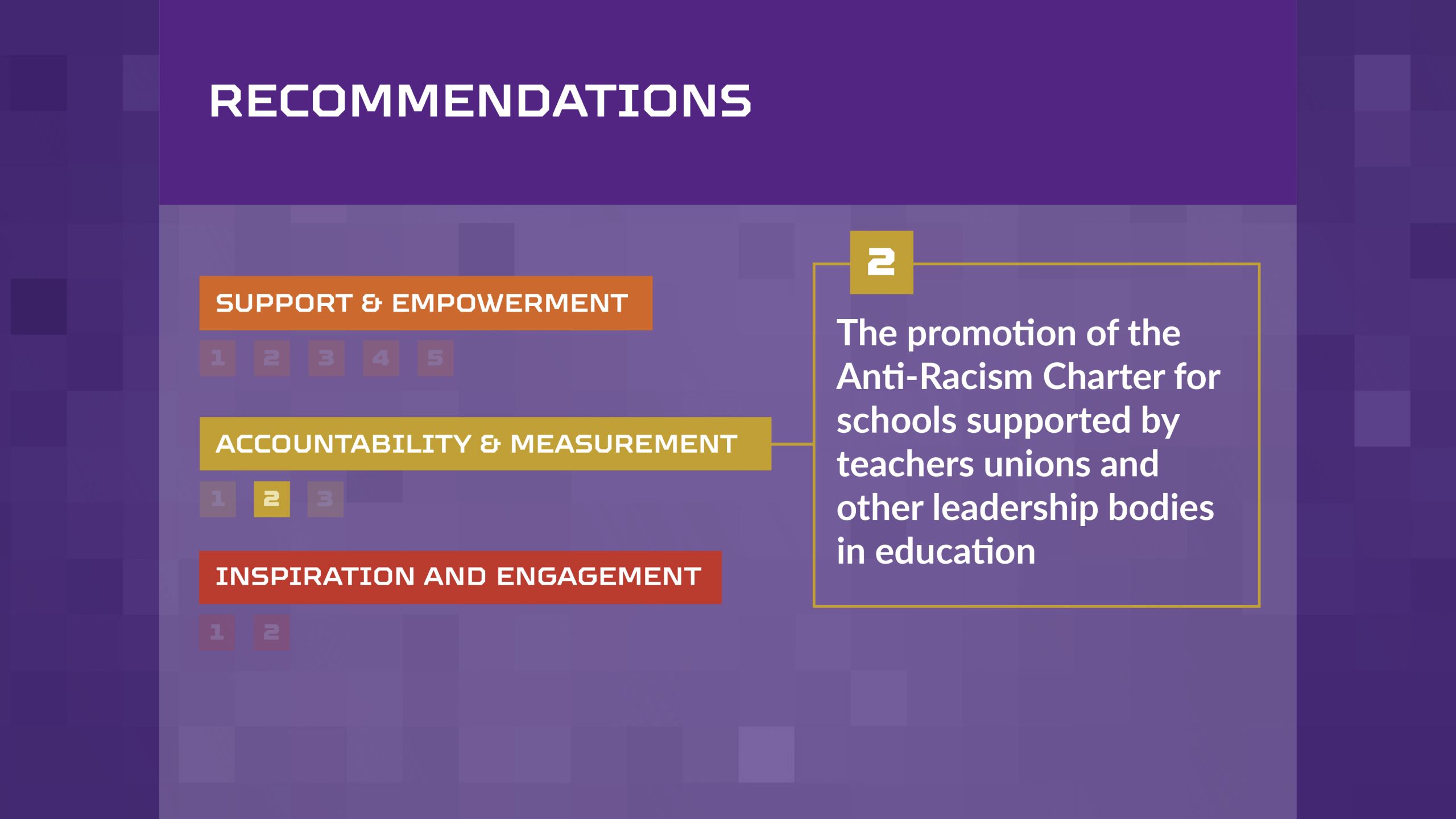
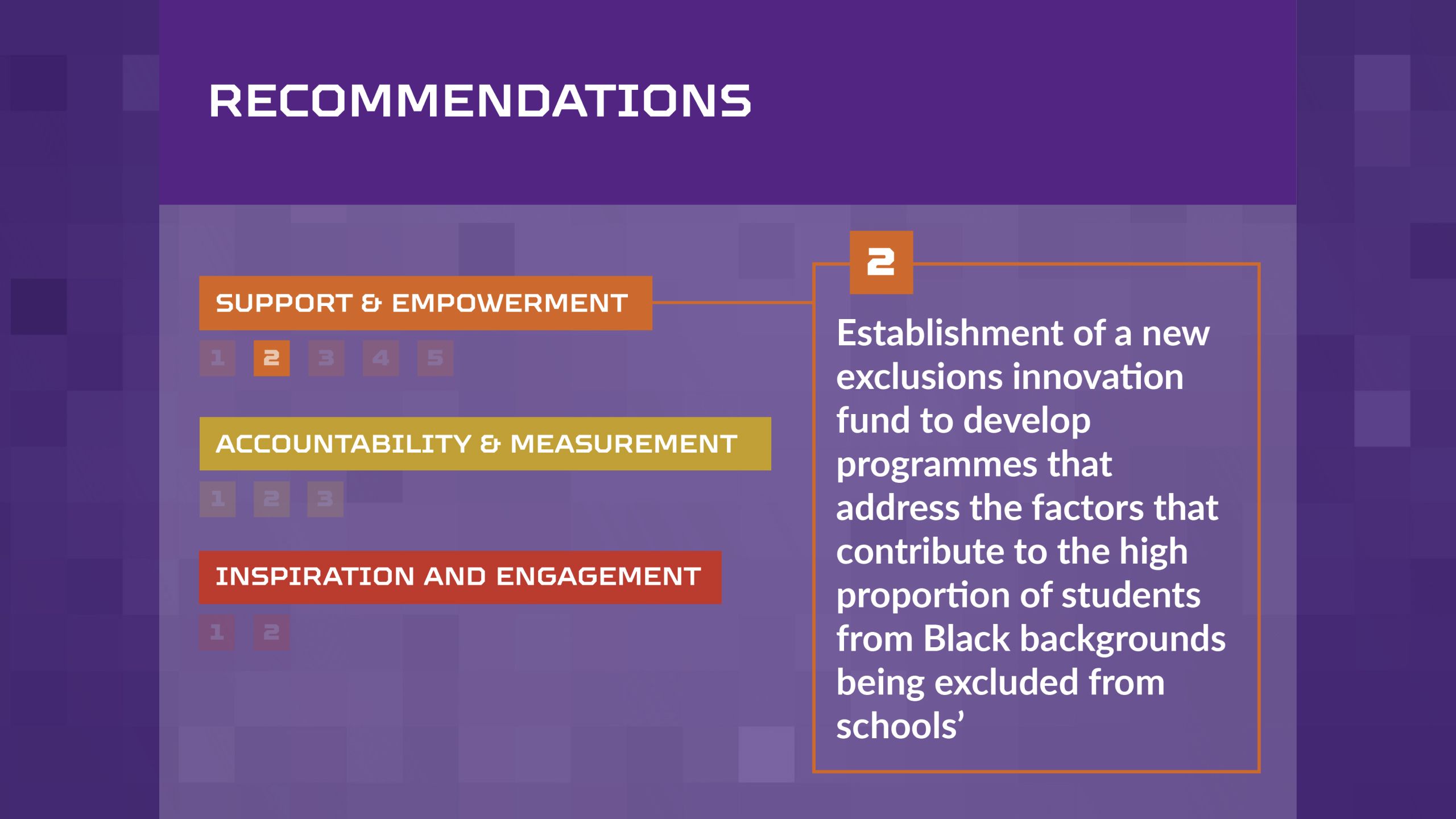
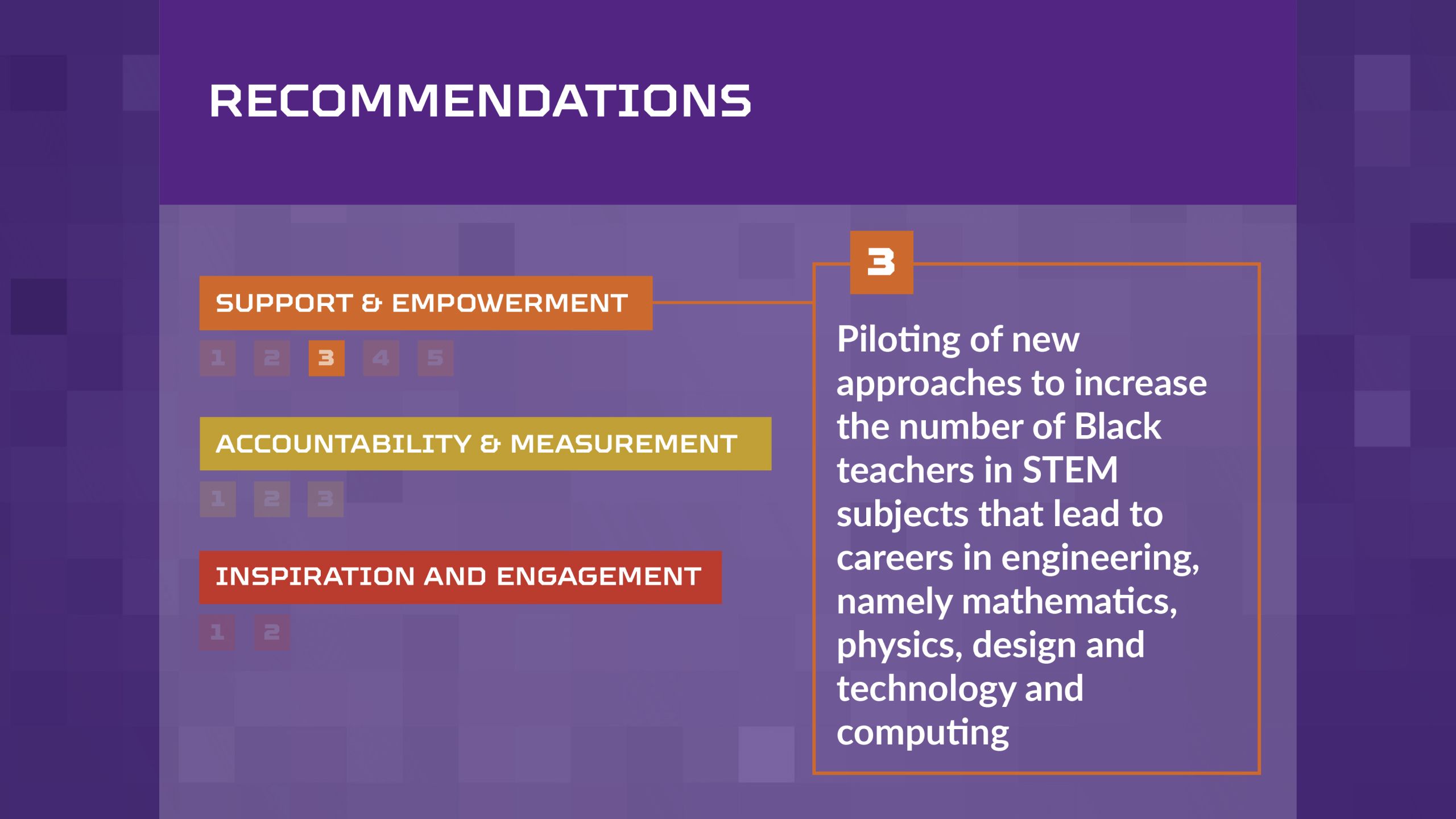
Experiences

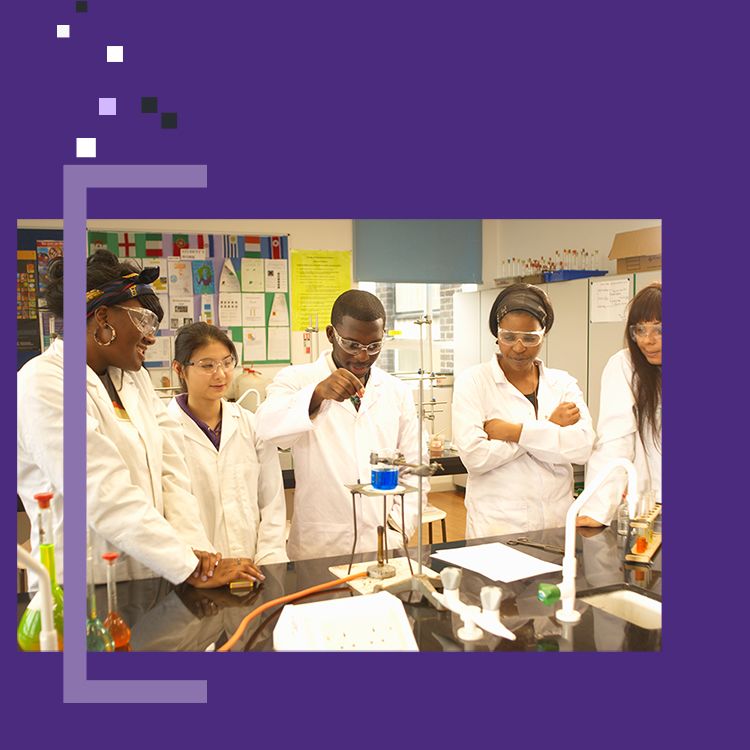
The Commission has explored the use of informal education support among Black communities as way of improving both attainment and engagement in STEM subjects.
There are a number of supplementary Saturday schools across the UK which support young Black people in their education. Black supplementary schools are mostly based in major cities and are generally organic, grassroots organisations, often run by women, with a history that reaches back into the 1950s. These schools provide community-led educational opportunities and may offer a unique opportunity to help young people to increase STEM attainment and encourage them to consider engineering pathways.
Research has shown that between 18% and 28% of all children from non-White British backgrounds had contact with a supplementary school at any one time.

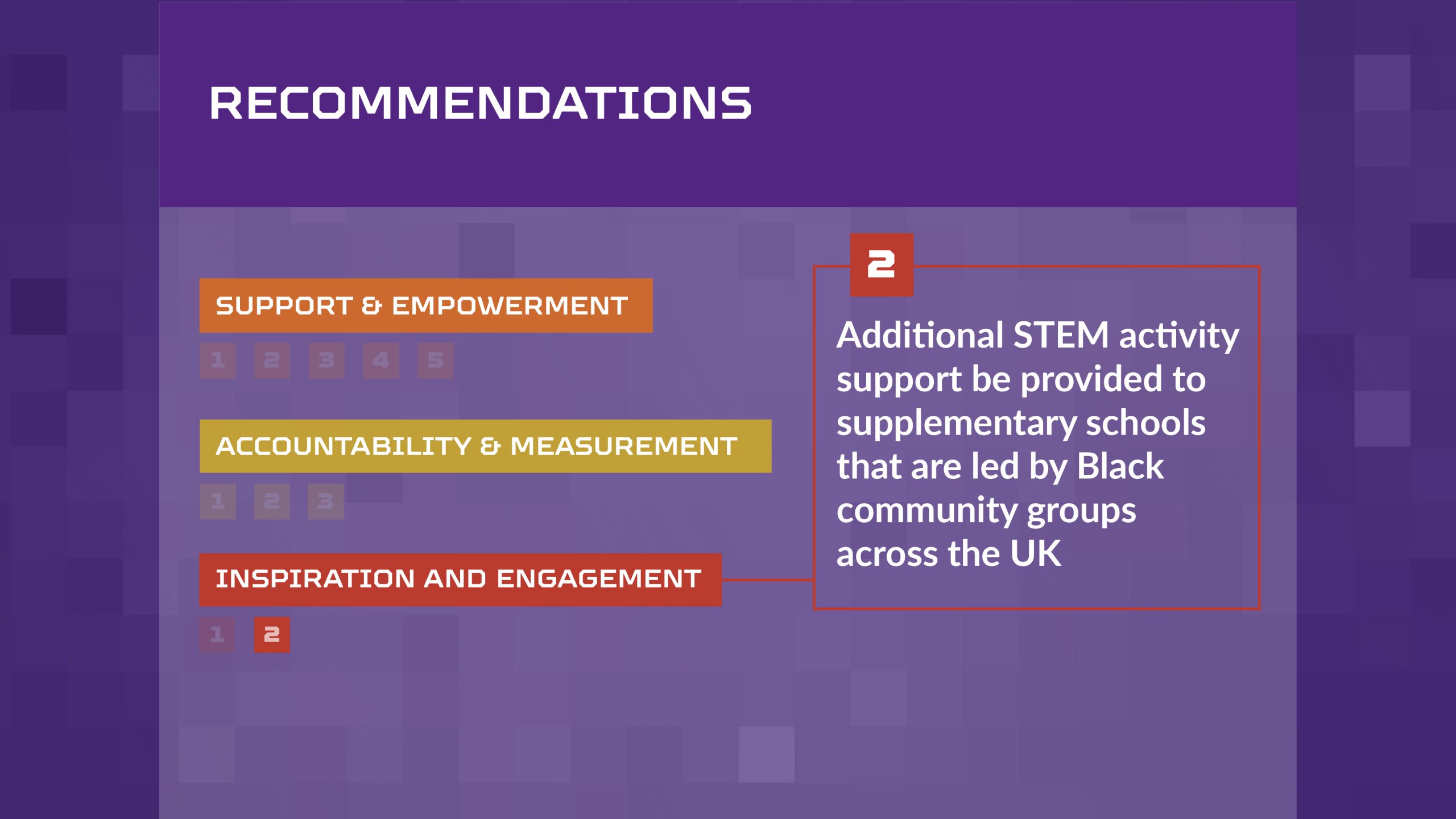
POST-16 &
HIGHER EDUCATION

Similar to GCSEs, there is a more positive picture for Black African students than for their Black Caribbean peers in terms of entry to and achievement in mathematics and physics at A level. Students of Mixed heritage also performed well.
However, because there are fewer Black students in the cohort, this equates to only 135 Black students achieving the necessary A* and A grades typically required for entry to the UK’s leading engineering universities in 2019.
Students encounter similar barriers in the Further Education sector to those in schools, such as low expectations and few role models. This is compounded by a lack of data on student attainment by ethnic groups, making it harder to assess the situation.
You can’t just be Black and study maths. You have to be Black and exceptional to study maths.
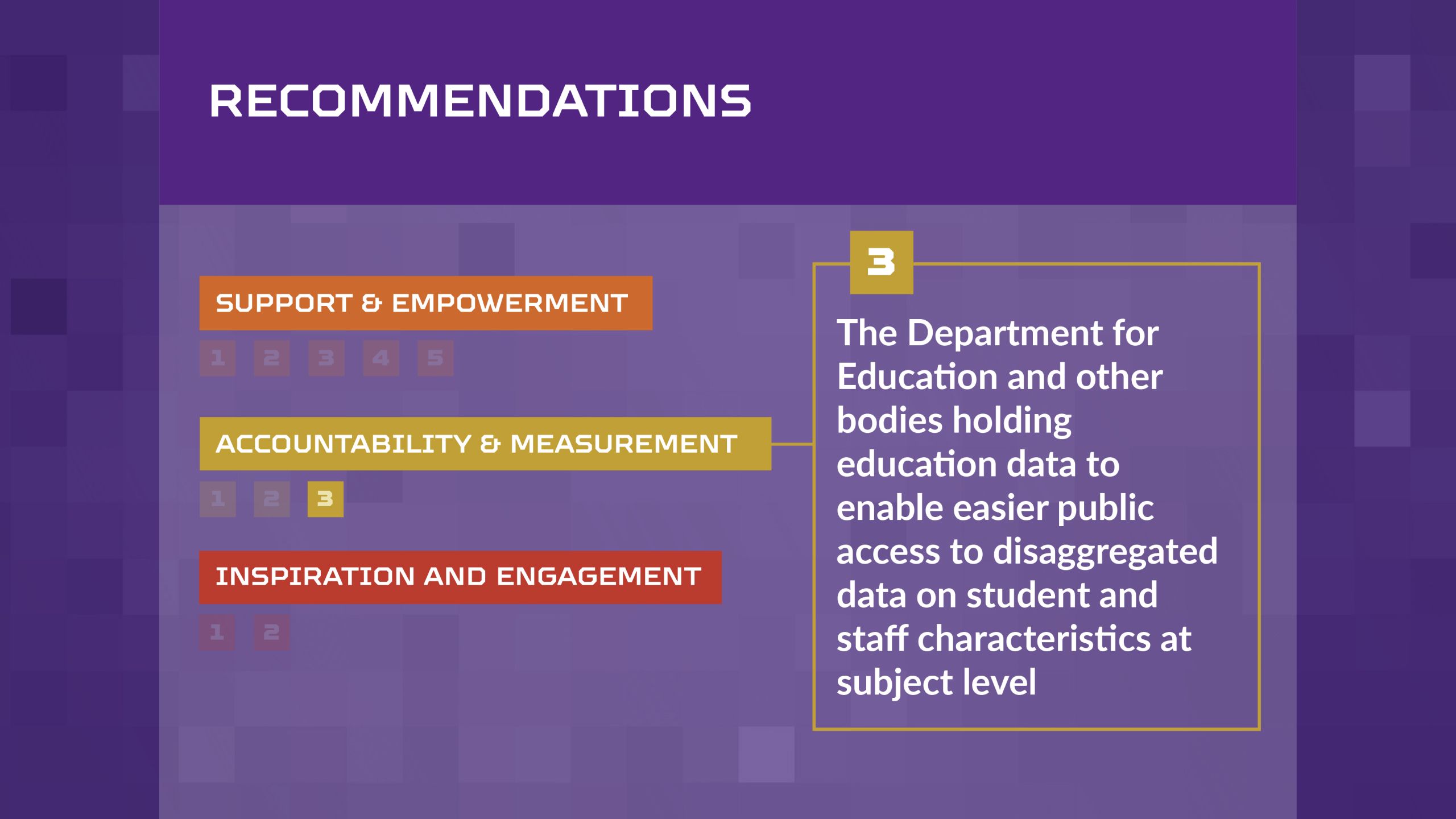
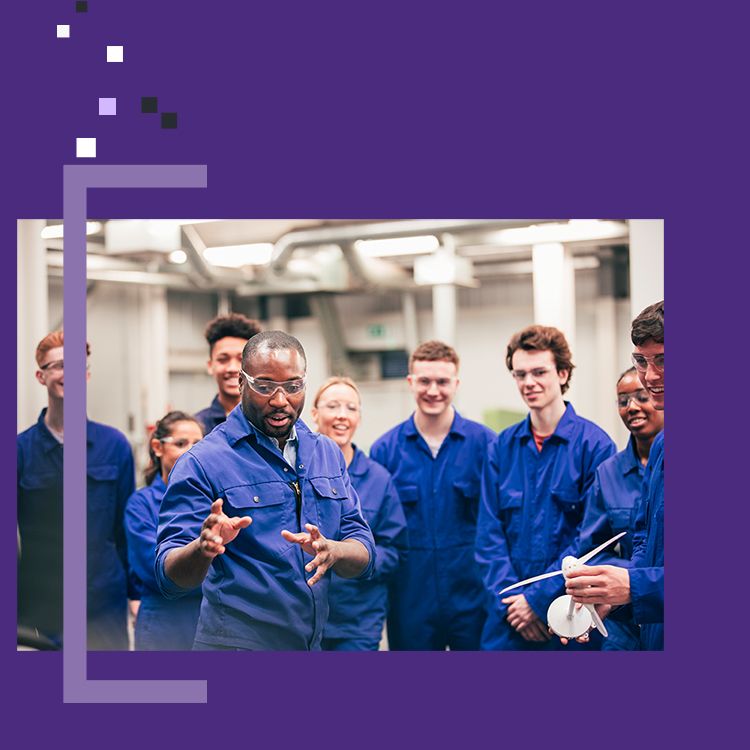
For those not wishing to go to university, the technician and mechanic career pathway into motorsport is through full time vocational and technical education or apprenticeships.
College based technical education
Despite the importance of these technical roles in the engineering and motorsport sector, there are few young Black people following this education pathway, with only around 2,300 Black students studying any form of engineering qualification in 2019/20 and fewer than 10 studying a motorsport qualification.
Apprenticeships
Apprenticeships are a second important pathway into engineering careers for those young people who do not want to follow an academic pathway.
There are various reasons for the low rates of participation of young Black people in the post-16 further education sector, including the following:
- Post-16 education is less valued, due to a lack of knowledge of technical education and technical career opportunities.
- The availability of apprenticeships in areas where they live.
- The limited recruitment of young Black people into apprenticeship roles by employers.
In addition, there appear to be challenges around the employment of young Black people into technical engineering positions which may be due to their lack of professional and social capital: they may not have friends, family and other contacts in professional roles who can help them. More practical careers support is needed to address these difficulties.

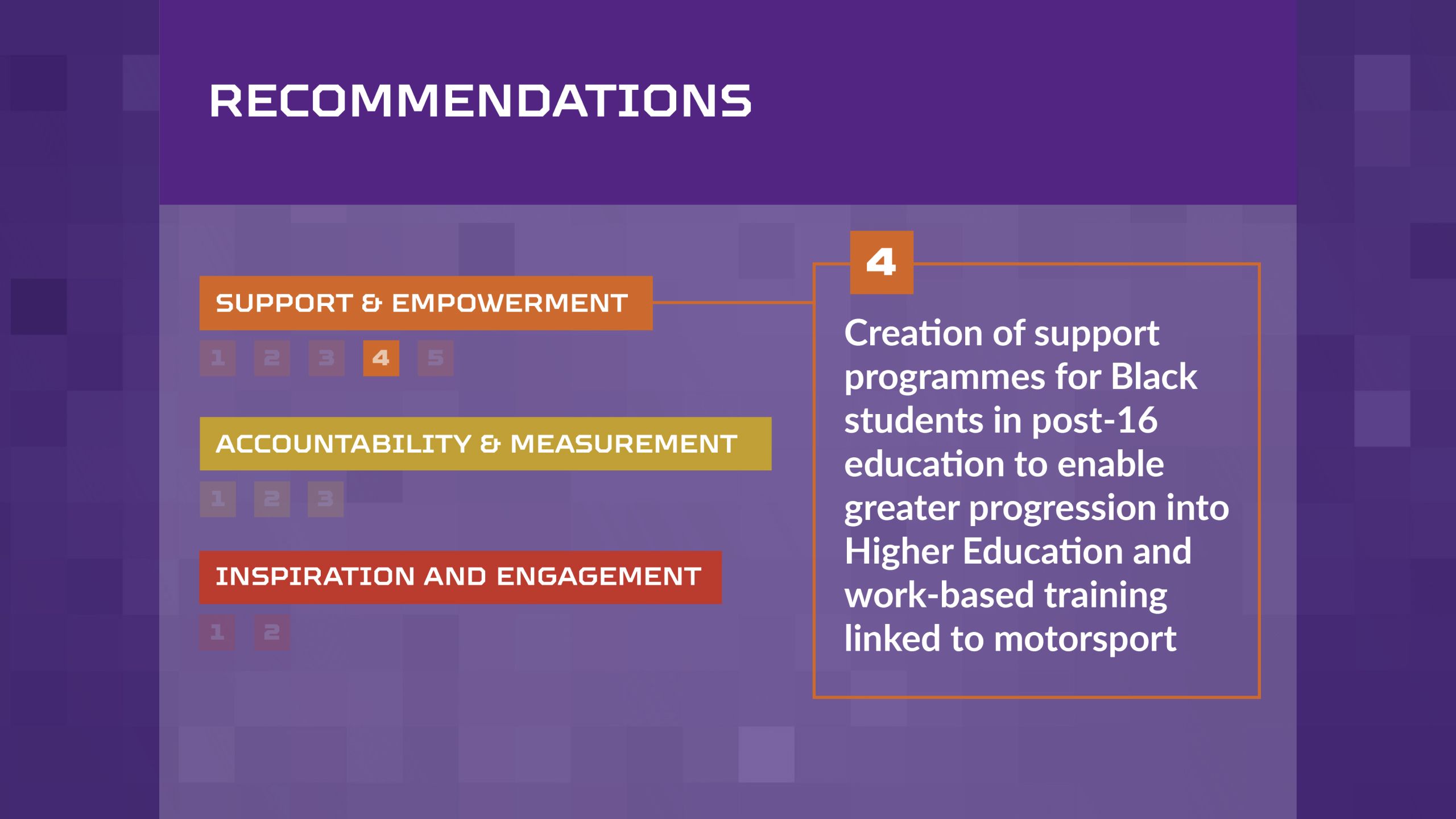
Experiences


The professional engineering pathway
For those young Black students wishing to access professional roles in the motorsport sector, a university undergraduate degree is the important final stage of their education.
The proportion of Black people studying engineering in UK universities is positive at around 5% of the engineering cohort in the 2019 academic year, roughly reflecting the proportion of Black students in the school system.
However, this equates to just over 3,800 students across all years of study. Just under a quarter of this Black engineering student cohort (820) study at the high-ranking Russell Group universities from which Formula 1 teams largely recruit their graduate engineers.

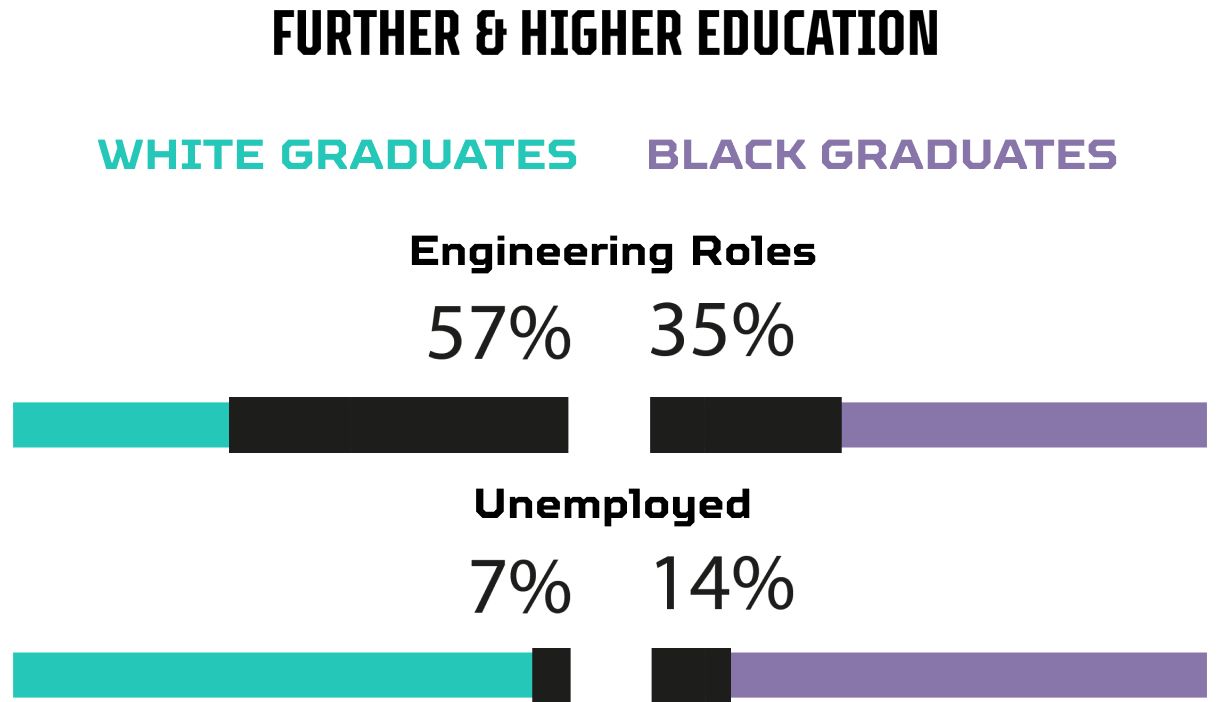
For Black students, the proportion achieving a 1st class honours degree in engineering is 20% - less than half that of their White British counterparts, at 43%.
Along with lower degree classification achieved by Black students, their employment outcomes are also less favourable.
Additional careers education support would be of significant benefit to Black engineering students in higher education. This includes the need for more opportunities to engage with employers, including industrial placements, careers networking opportunities and job application support.

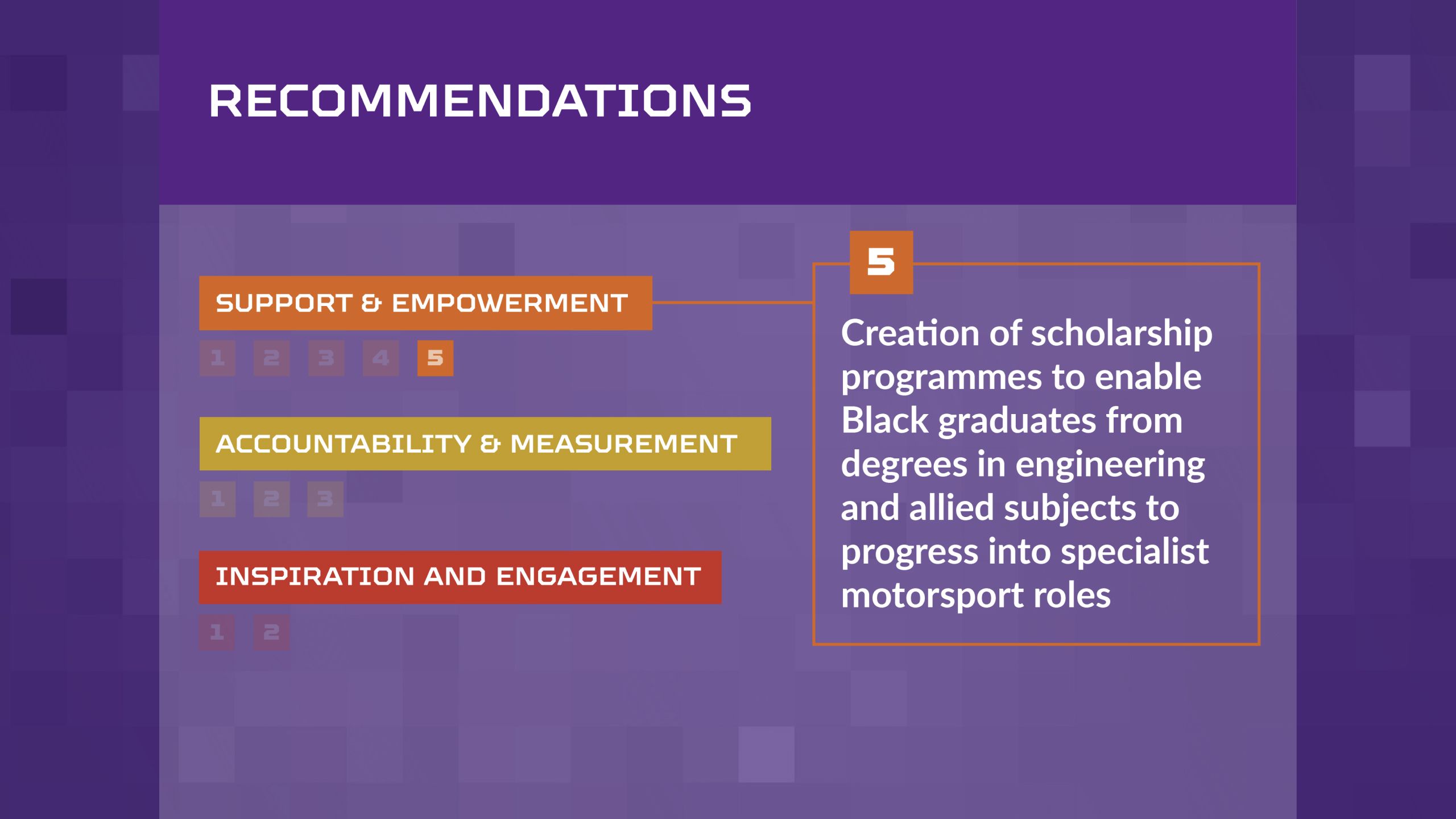
ACTION

To sum up, we call on people in leadership roles in motorsport, education and beyond, to come together and join with Lewis Hamilton and the Hamilton Commission in acting on our recommendations.
The motorsport sector
Formula 1 is a no-compromise sport. Teams are fiercely competitive, and they only want to recruit the best. But this notion of what they consider to be the best is challenged in this report.
Motorsport teams, and the supply chain companies supporting them, have to be more inclusive in their recruitment practices and workplace cultures.
Education and the talent pipeline
More needs to be done to address both the lack of knowledge about engineering in schools and the barriers, identified in this report, that prevent young Black people from pursuing STEM education and career.
The Commission recommends three strands of action:
- Support and empowerment: we call on those in leadership positions to support Black children to excel in STEM subjects, and to empower them to choose – and succeed in – fulfilling careers
- Accountability and measurement: we call on those in leadership positions to step up, to acknowledge the unfairness that exists and to commit to change – the first step being to collect data to form a benchmark from which to improve.
- Inspiration and engagement: we call on those in leadership positions to work harder to show Black children that STEM subjects, engineering and motorsport ARE for them, and to excite them about the opportunities that they offer.
Although this report has focused predominantly on the progression of Black people into engineering and motorsport, we hope that it will act as a stimulus for wider action. Not only do we hope to see more Black people in motorsport, we hope to see more Black people in engineering more generally, and more Black children studying and achieving in STEM subjects.
We also hope that our recommendations will help to address the inclusivity challenges faced by people from all minority ethnic backgrounds and other underrepresented groups in motorsport, engineering, education and employment more widely.
Lewis Hamilton has blazed a trail through motorsport. The young Black boy who was told he had no potential is now a Seven-Time World Champion. He set up The Hamilton Commission to help others have the opportunities to shine that all young people deserve.
“We always had the dream of helping to enact change in this industry. We always had the passion, the focus. All we needed was to know the facts.”
Thanks to the work of the Commission, we have the facts. The time for change is now.
